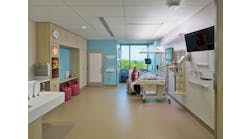At most larger manufacturing plants, employees enjoy a full-service cafeteria. There is no need to pack a lunch, though it is often still an option. Either way, you can wash up and then enjoy your lunch in a clean environment. At the other end of the spectrum, service techs and construction electricians may work on a site with no facilities and/or no obvious place for breaks and lunches. You have to bring your food, and that can create problems.
Let’s say that, among other things, you pack a sandwich in your lunchbox. If it’s got any kind of protein (egg salad, peanut butter, chicken, lunchmeat, cheese) in it, it needs to be kept cold. In fact, it needs to be kept at about 40ºF (the same as your refrigerator) or less. Cold-packs are made for this purpose. If the food is not kept cold, it could be laden with illness-causing bacteria by the time you eat it. The results may include an embarrassing episode in which you almost make it to the bathroom in time.
An insulated lunchbox that can accommodate cold packs (which you freeze ahead of time) is one choice. Maybe you also like hot soup; in that case you’d need a separate soup thermos. Just as cold protein items for sandwiches must be kept cold for hygienic reasons, most soups also must be kept hot for hygienic reasons. But you want to have a banana and an apple at break time, those are best neither cold nor hot. Putting all three temperature range items in one box doesn’t work.
You might want to shop around a bit for a meal-carry system that fits your particular needs. Another option is to purchase meal kits. You don’t even make your own meals to pack, that’s done for you. Just don’t settle for a cheap lunchbox that doesn’t safely store your food for the several hours you’ll need it stored.
Most sites have designated areas for eating and drinking. This way, you’re not getting airborne grinding dust or other toxins on your food or in your drink. If you’re on a small site with no such area, what should you do? Find a place away from the work area itself. Maybe you can drive or walk a short distance offsite. But make sure it’s safe. Many people will go to a remote area of a construction site, not connecting the dots that it’s remote because those MV transformers need to be away from people. It’s not safe to sit down by transformers or other equipment. Also avoid being anywhere near cooling towers (even the small ones), they often have antifreeze or other chemicals in the water.
Can you safely handle your food? It’s hard telling what you’ve gotten onto your hands while working. Rather than take a chance, wash and dry your hands before eating. If you know ahead of time there’s no facility for that, bring moist towelettes for the purpose. If you forgot those and don’t have a way to clean your hands, another option is to put on nitrile gloves before eating; whatever is on your hands won’t get on your food.
Finally, make sure you clean up when done. If possible (and there’s a suitable drain), rinse your food containers and dry them before putting them away. If not possible, use the moist towelettes. The reason for this step is so they don’t reek by the time you get them home.
Once you’ve stowed your food containers, make sure you haven’t left any scraps or waste where bugs and rodents can feed on them. Collect any bottles, cartons, cans, towelettes, paper towels, wrappers, etc., that you or coworkers may have left and properly dispose of them. If a trash can is provided, make sure no liquids are tossed in there. A half full soda can will cause a significant mess if the trash bag has a leak (and they always do). This last rule applies in that nice cafeteria, also.




